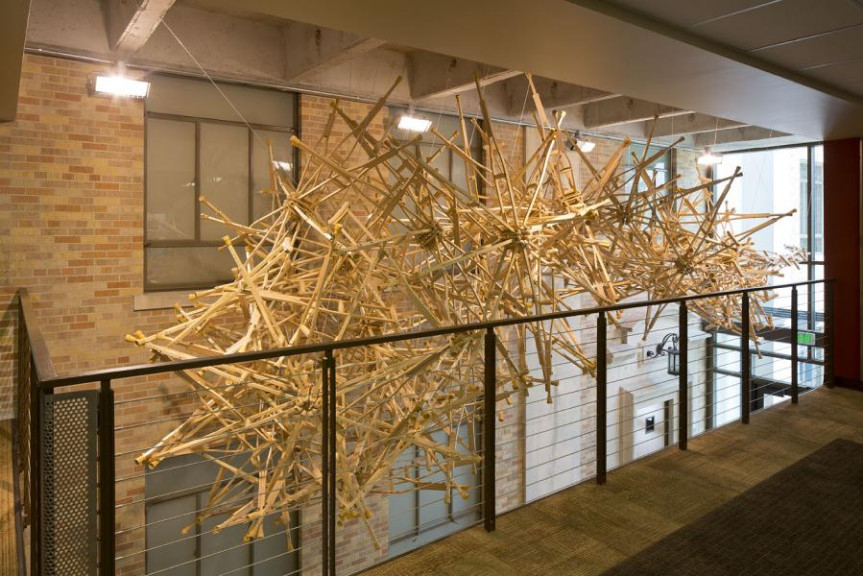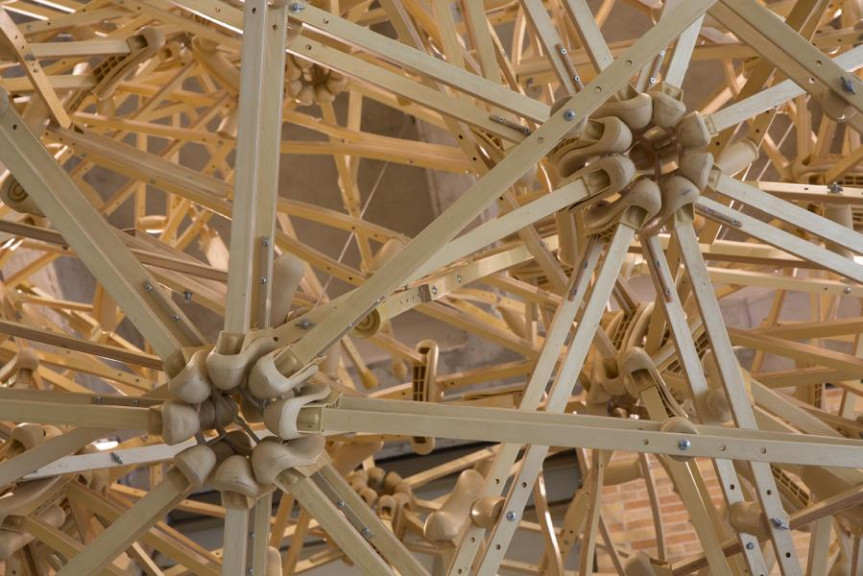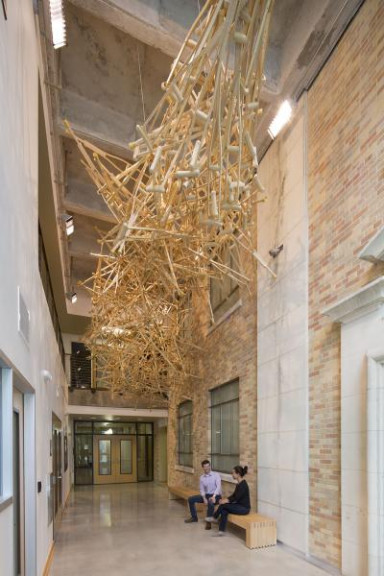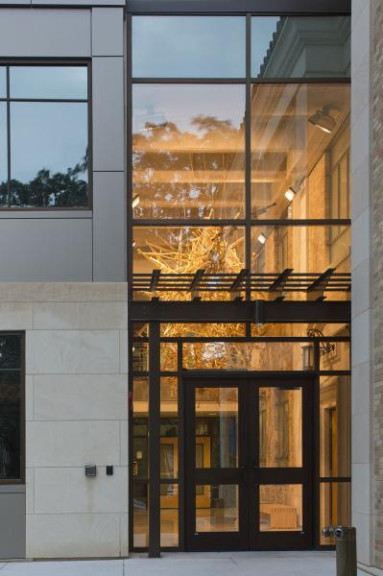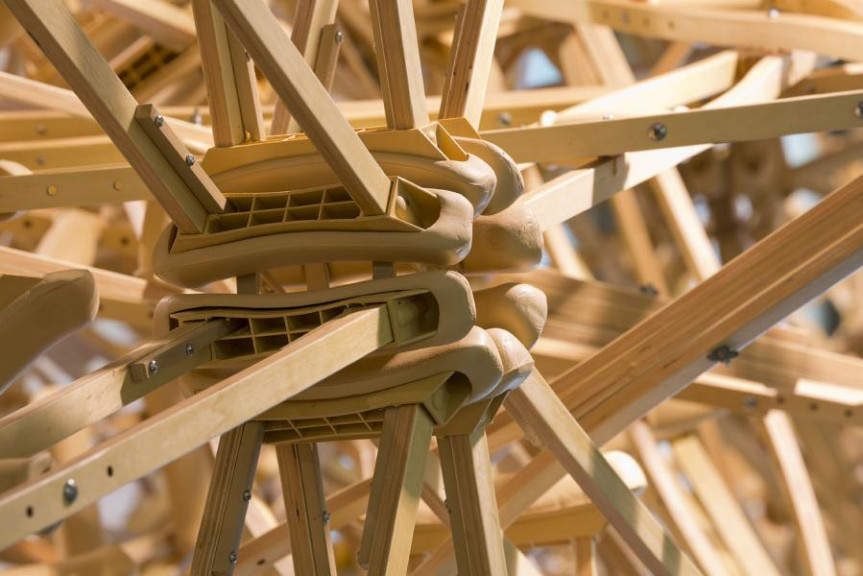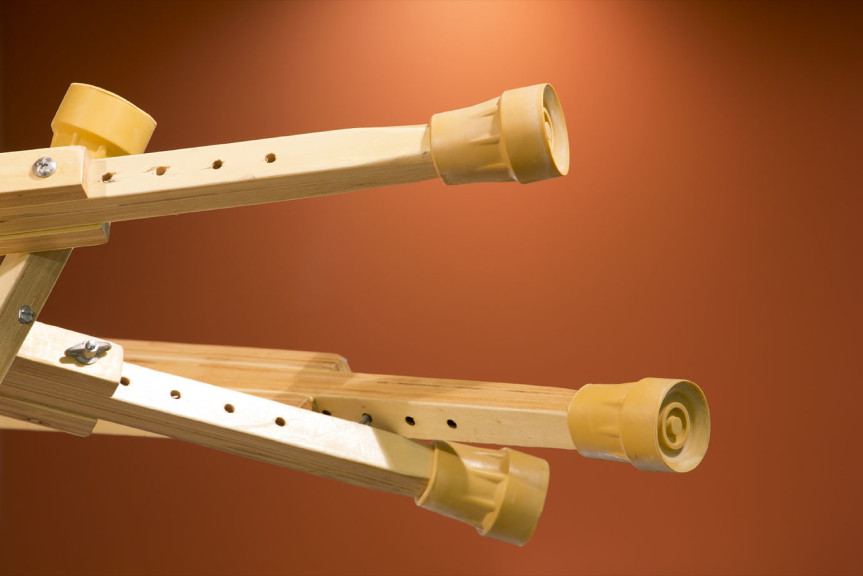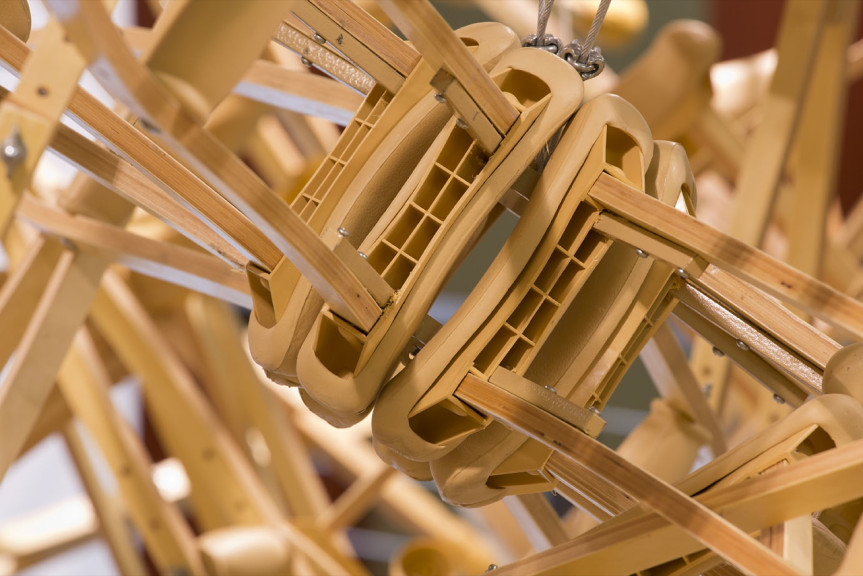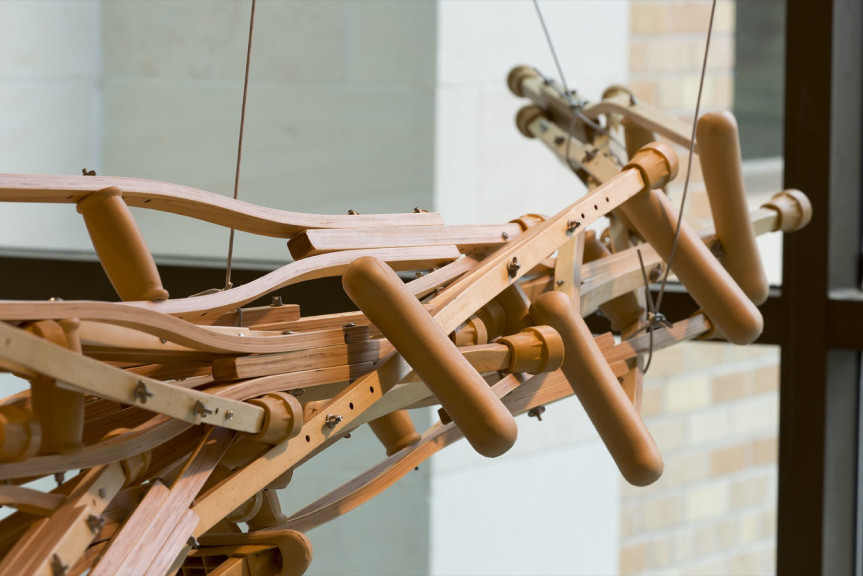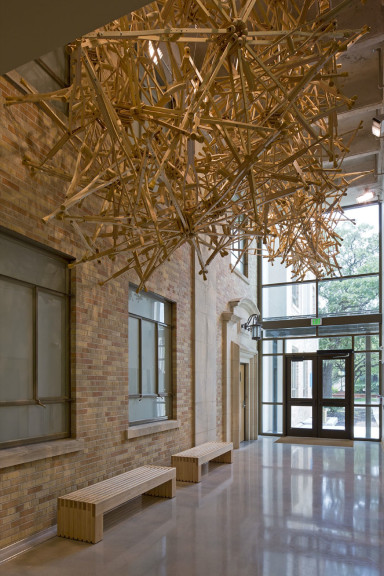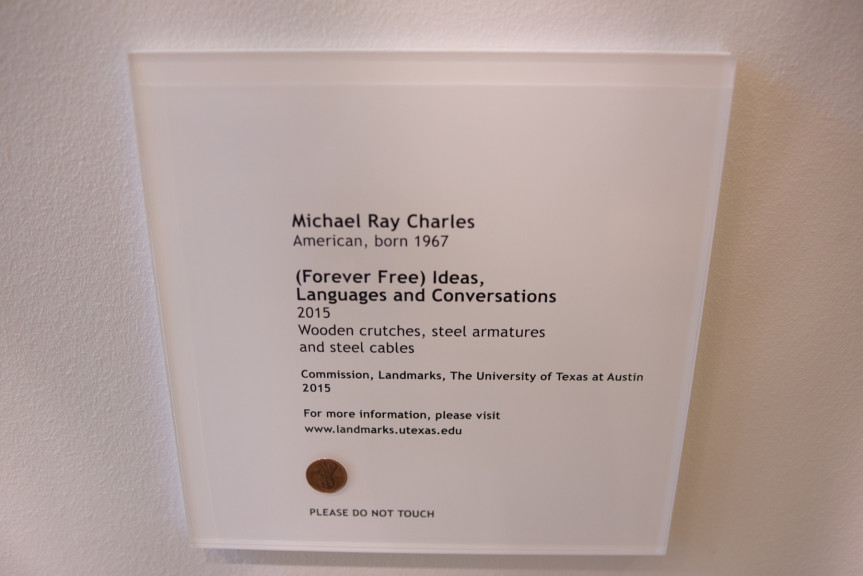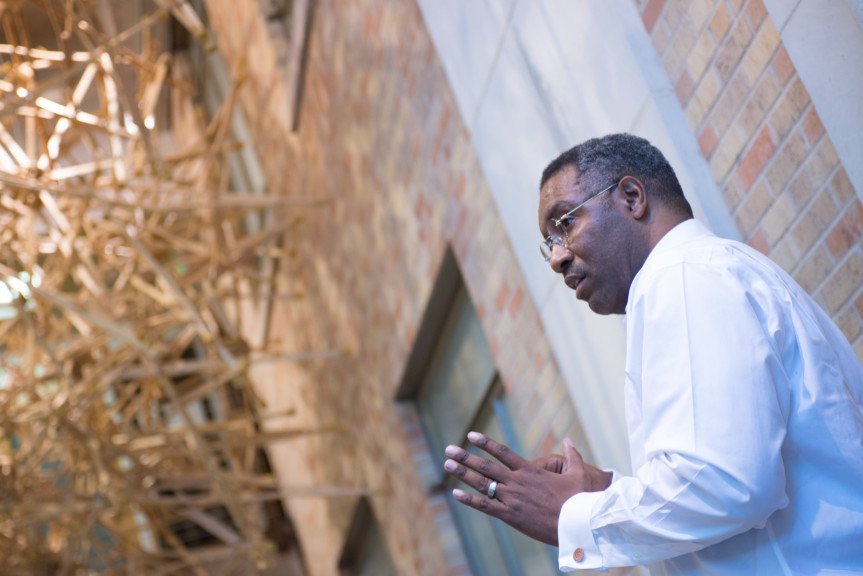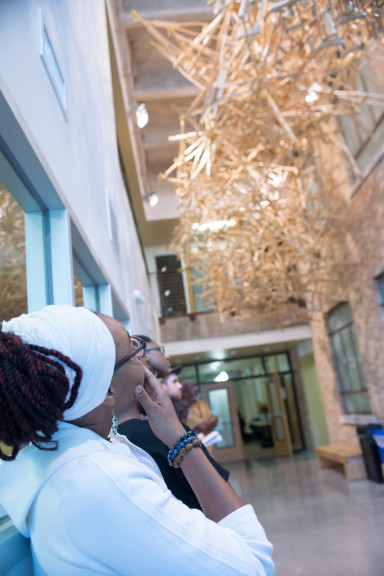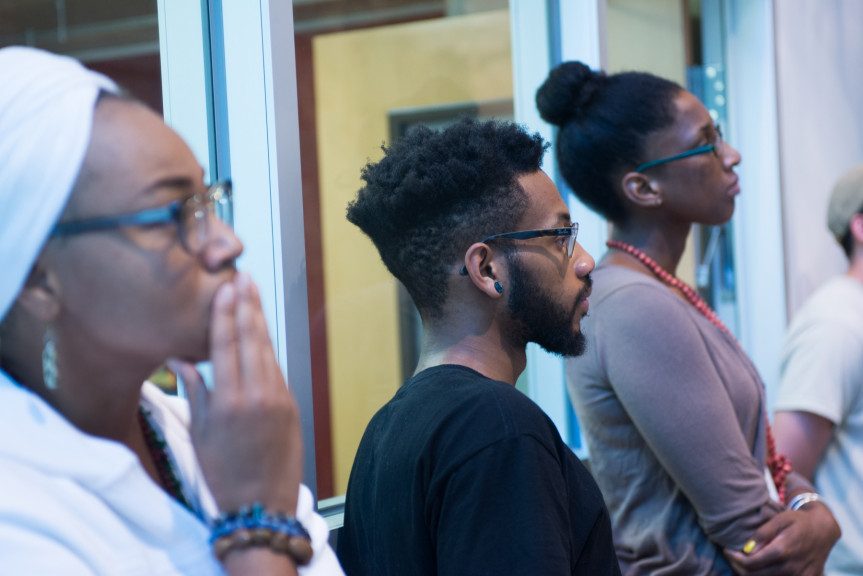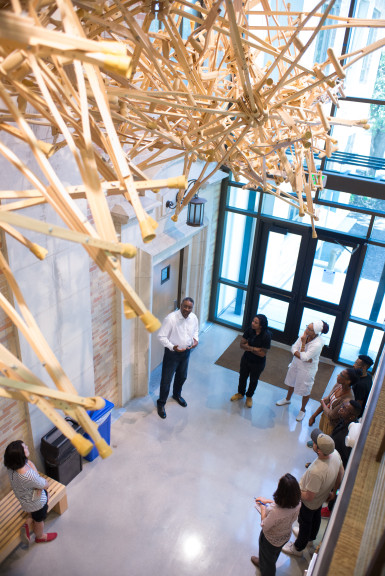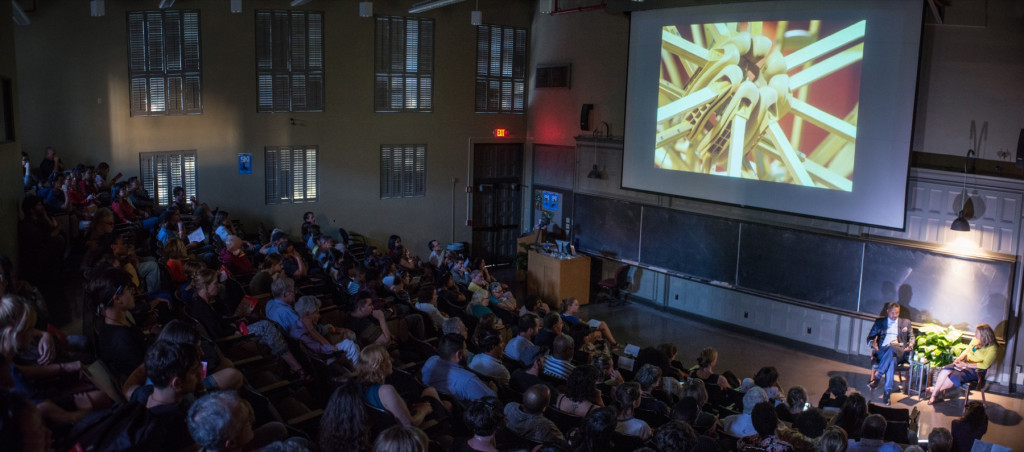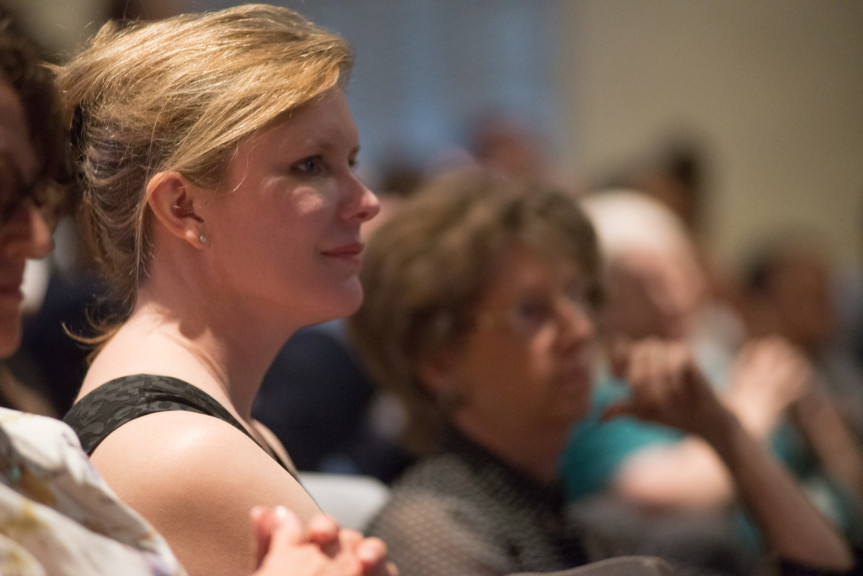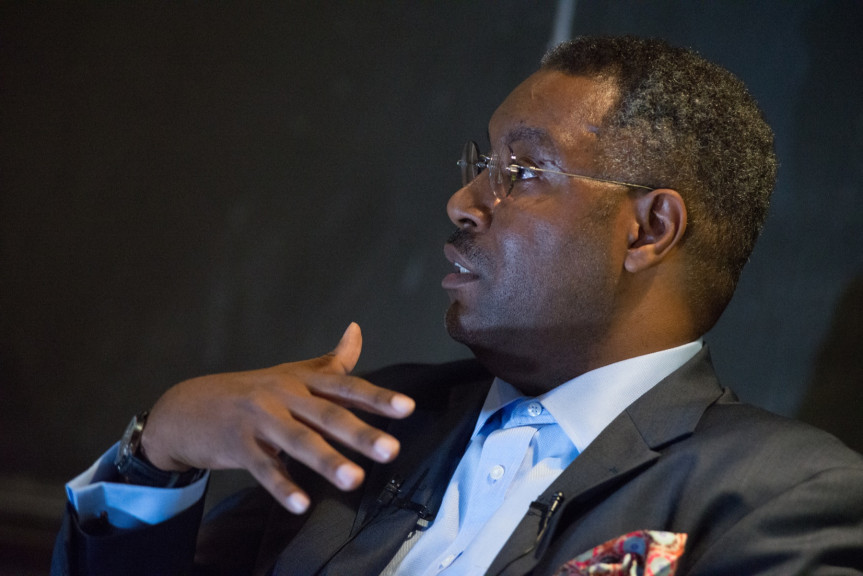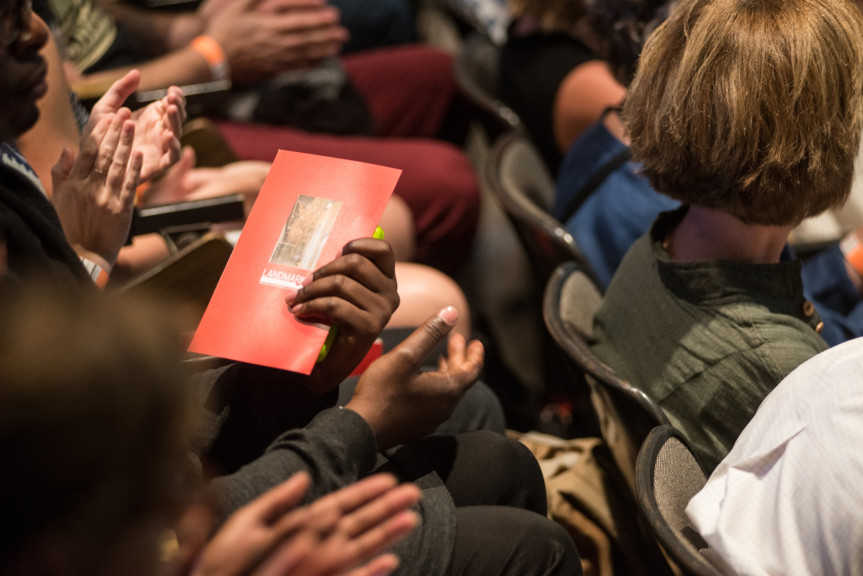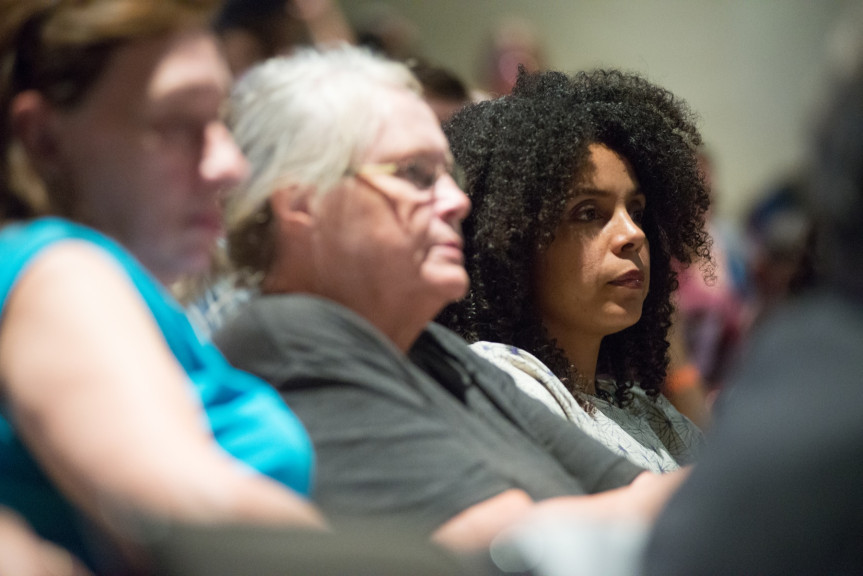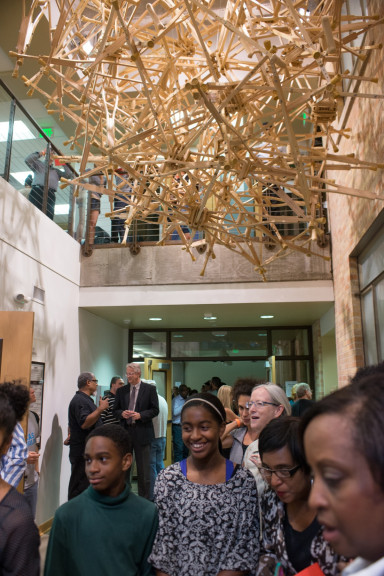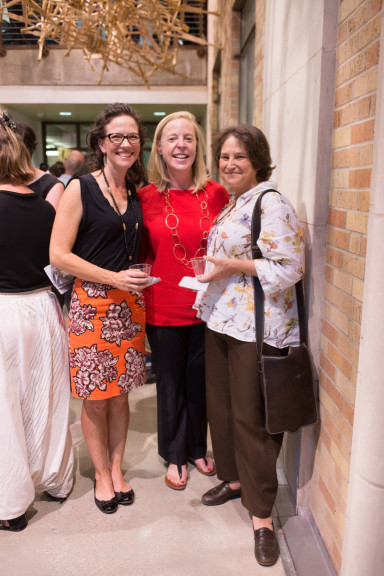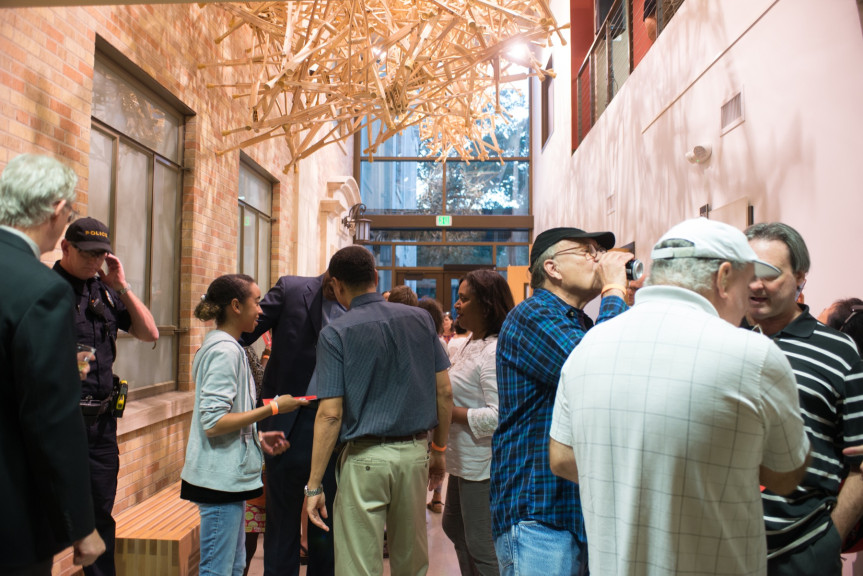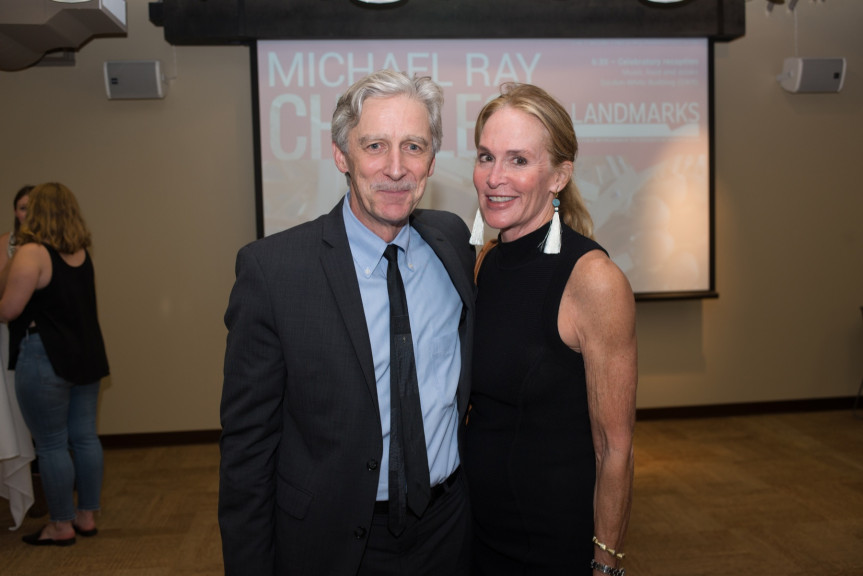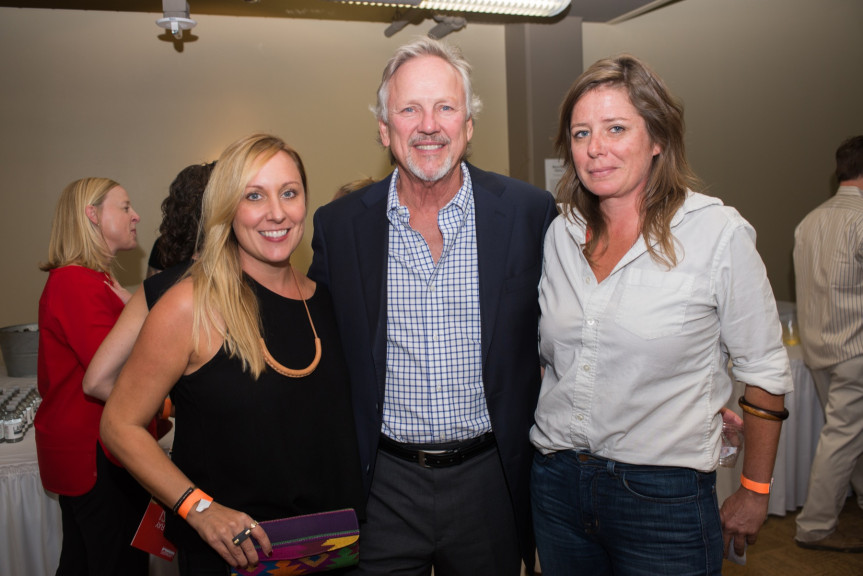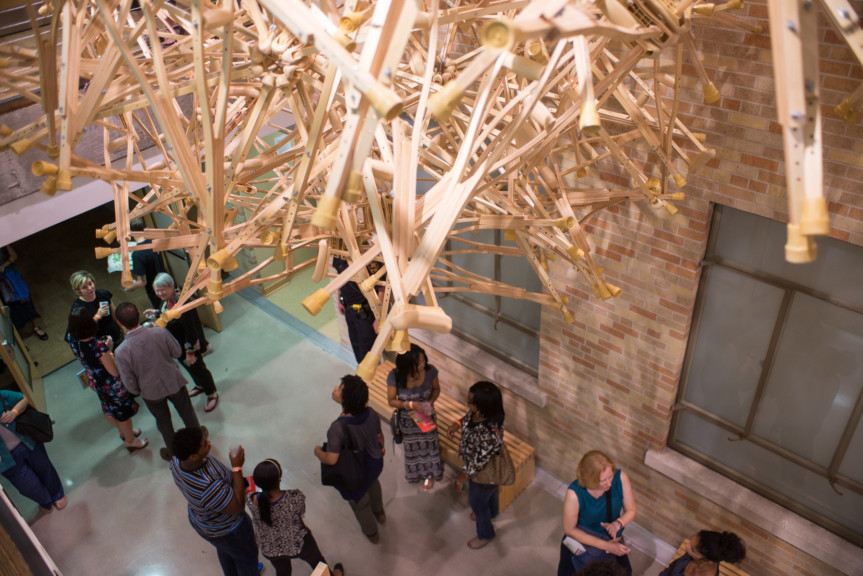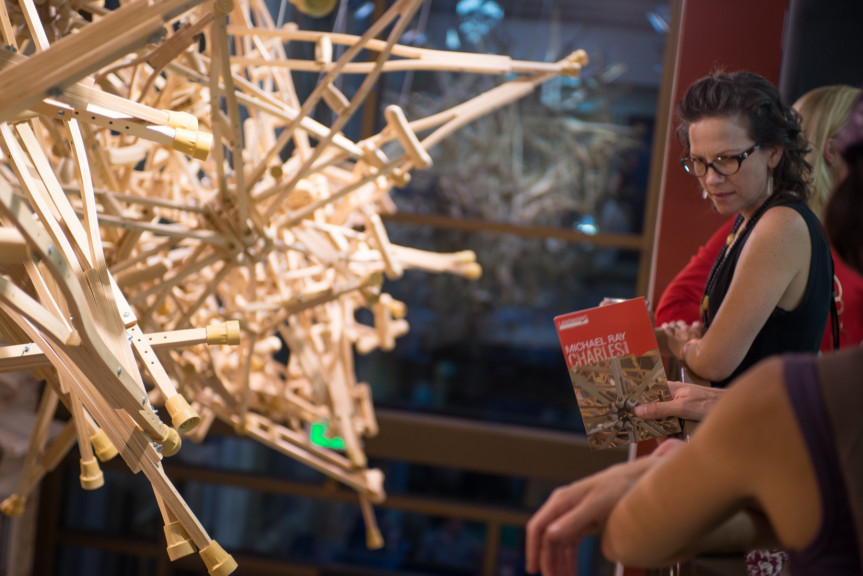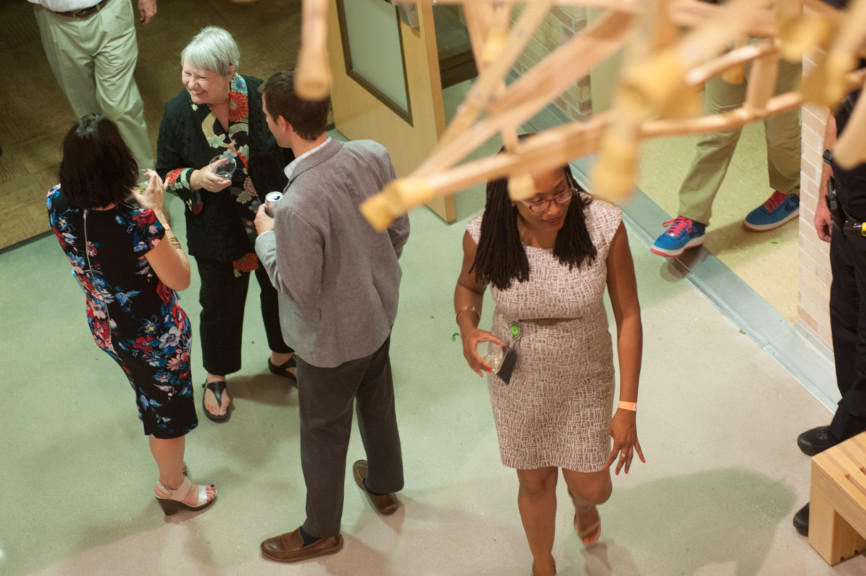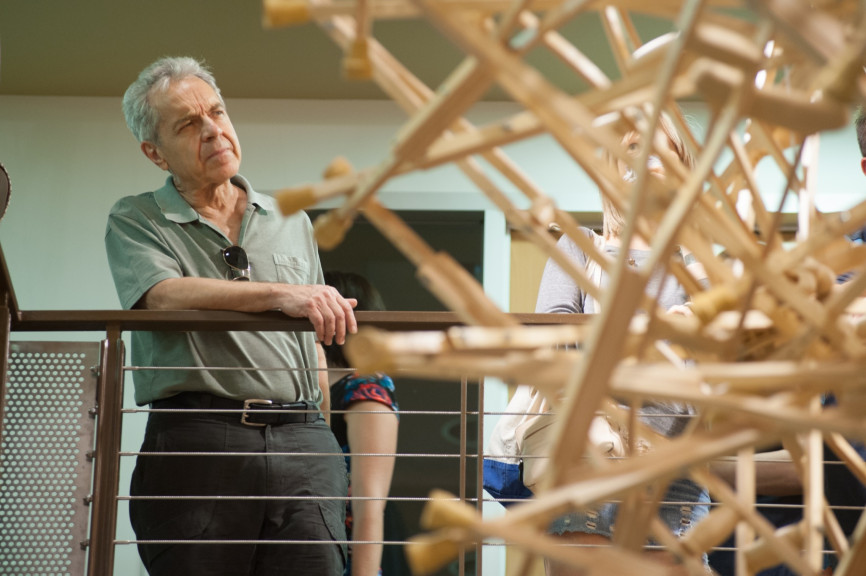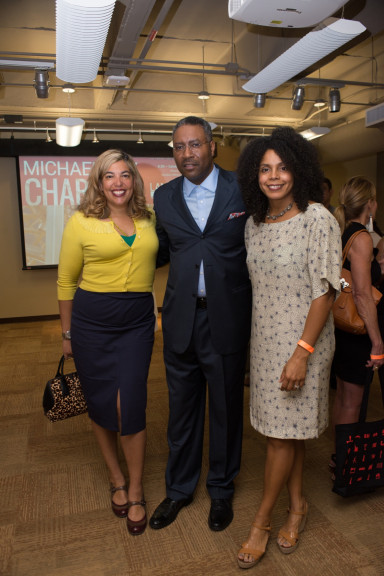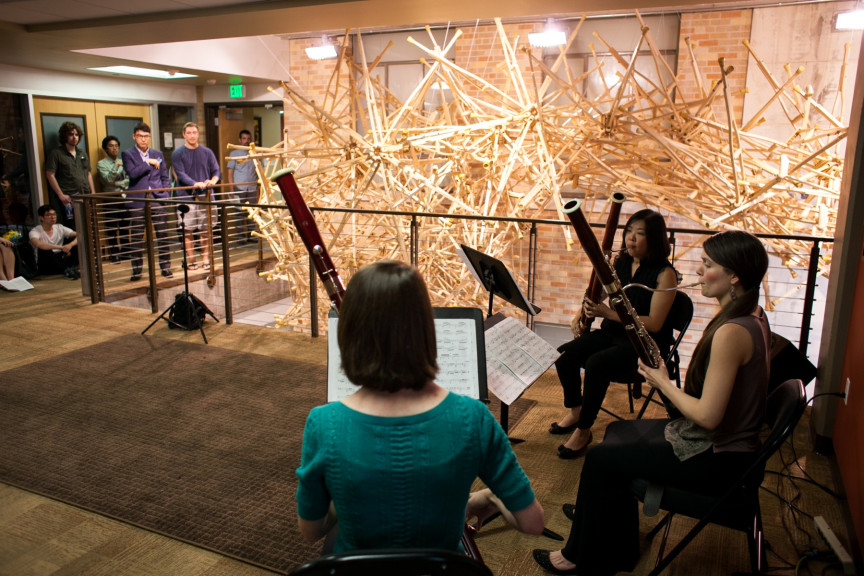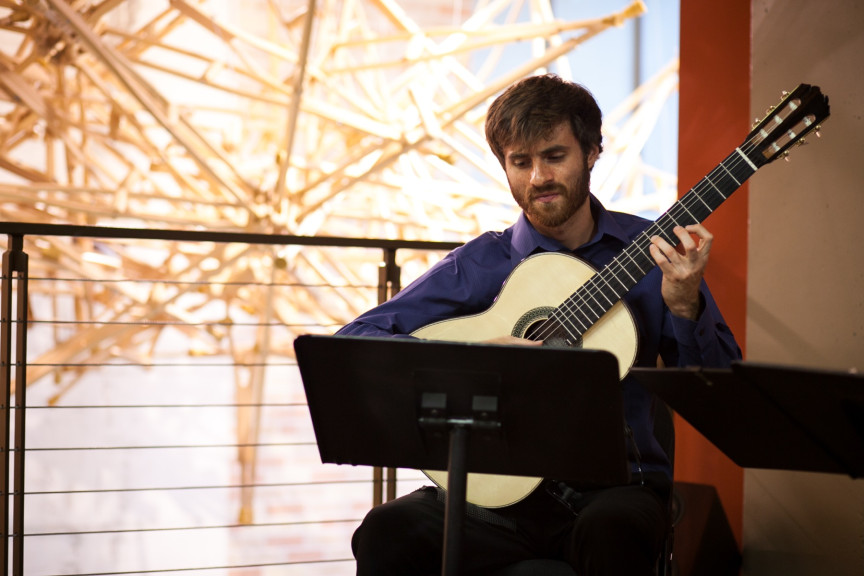Michael Ray Charles was born in Lafayette, Louisiana, in 1967, when the nonviolent Civil Rights Movement was giving way to riotous social and cultural upheaval. Like artists Kara Walker (born 1969) and Fred Wilson (born 1954), in his work Charles explores African and African American oppression and prejudice. He is best known for work that appropriates derogatory images in order to disparage racist stereotypes. For (Forever Free) Ideas, Languages and Conversations, Charles departs from this mode and takes a more metaphorical approach, explaining, “Conceptual and representational applications of power throughout visual cultures past and present have been among my most significant triggers of creative inspiration.”
(Forever Free) Ideas, Languages and Conversations is suspended in the atrium of the Gordon-White Building, home to centers that are committed to studying the history and experience of minority cultures. Charles selected the location because it joins a classic 1952 university building to a newly constructed addition used by students and scholars of the historically marginalized. In designing the atrium’s interior, he preserved architectural ornaments from the original building and added rough, exposed surfaces to create a meaningful segue into the polished departmental offices. The result is both sculpture and site—a symbolic transition between the inherited establishment and a future that explores new ways of thinking and being.
Charles’ sculpture is made from wooden crutches assembled in groups to create star-shaped wheels. The individual parts maintain their own trajectory, yet form a common mass in an energetic composition. When imagining the project, Charles was partly inspired by the activity of scholars who study minority cultures and the challenges they have faced in academic institutions. (Forever Free) Ideas, Languages and Conversations, now the centerpiece of a thriving enterprise that champions multiculturalism and diversity, is emblematic of institutional progress and transformation. By claiming the wounds of the past and acknowledging the support needed to heal, it recognizes all who have suffered inequality and carries the promise of future growth and hope.
More information
Landmarks commissioned artist Michael Ray Charles to create a site-specific sculpture for the atrium of the Gordon-White Building. Composed of hundreds of wooden crutches, Charles’ sculpture and the surrounding architecture symbolize progress, transition, and transformation.
Funding for (Forever Free) Ideas, Languages and Conversations was provided by the College of Liberal Arts as a portion of the capital improvement project. This project as the result of a collaborative effort among many and Landmarks would like to give special thanks to the following:
Leadership
Andrée Bober and Landmarks
Pat Clubb and University Operations
Kevin Cokley and the Institute for Urban Policy Research and Analysis
Douglas Dempster and the College of Fine Arts
Randy Diehl and the College of Liberal Arts
Gregory L. Fenves and the Office of the President
Edmund Gordon and the African and African Diaspora Studies Department
Nicole M. Guidotti-Hernández and the Department of Mexican American and Latino/a Studies
Landmarks Advisory Committee
Domino Perez and The Center for Mexican American Studies
Bob Rawski and the Office of Facilities Planning and Construction
David Rea and the Office of Campus Planning and Facilities Management
Cherise Smith and the John L. Warfield Center for African and African American Studies
Gregory Vincent and the Division of Diversity and Community Engagement
Project Team
Nisa Barger, project manager, Landmarks
Andrée Bober, curator and director, Landmarks
Susan Frocheur, ARCHITEXAS
Bart Kleiman, Office of Facilities Planning and Construction
Ozie Monroe, installation services
SpawGlass
Special Thanks
Tony Araguz, African and African Diaspora Studies Department
Grant Barger, College of Liberal Arts
Deb Duval, event coordinator
Myra Gibbs, Department of Mexican American and Latino/a Studies
Severine Halls, Office of Facilities Planning and Construction
Gilles Heno-Coe, collections management, Landmarks
Stephanie Lang, John L. Warfield Center for African and African American Studies
Nick Nobel, external affairs, Landmarks
Anna-Lisa Plant, John L. Warfield Center for African and African American Studies
Erica Saenz, Division of Diversity and Community Engagement
Gwendolyn DuBois Shaw, curatorial contributor
Stephanie Taparauskas, development, Landmarks
Joe Tenbarge, College of Liberal Arts
Jennalie Travis, development, Landmarks
Misa Yamamoto, College of Fine Arts
Catherine Zinser, education, Landmarks
Michael Ray Charles’ '(Forever Free)' sculpture a powerful critique at UT
Jeanne Claire van Ryzin, Austin-American Statesman, 10 October 2015
There is still much miscommunication, Charles says, between the past and the present. And progress intellectually, politically or socially will reveal existing wounds that each generation must grapple with. Compiling wooden crutches into wheels poised to move is Charles’ nod to those African-American scholars who have done the best with whatever a university establishment has handed them.
Landmarks Debuts Michael Ray Charles Sculpture at UT
Robert Faires, The Austin Chronicle, 09 October 2015
Charles may no longer teach at UT – in 2014, he joined the faculty at the University of Houston, his alma mater – but he's the first artist with strong ties to the 40 Acres to be hired by Landmarks to create a new work for its collection, an achievement that adds even more value to this already priceless collection of public art.
Michael Ray Charles Adds Installation to UT’s Landmark Collection
Paula Newton, Glasstire, 08 October 2015
Best known for his vintage advertising-looking paintings and his aggressive use of caricature and racial stereotypes, this huge sculpture seems out of place. But the “location of the work within the Gordon-White Building is key to its meaning,” writes catalogue essayist Gwendolyn DuBois Shaw.
Landmarks to Celebrate Newest Public Art Work at The University of Texas: Michael Ray Charles’ (Forever Free) Ideas, Languages and Conversations
Artist Q&A and reception to take place 15 October
Austin, Texas – 3 September 2015 – On 15 October 2015, Landmarks, the award-winning public art program of The University of Texas at Austin, will celebrate its latest installation: (Forever Free) Ideas, Languages and Conversations by artist Michael Ray Charles. Suspended in the atrium of the Gordon-White Building at 24th Street and Whitis Avenue, the sculpture features hundreds of crutches assembled into interconnected forms. A Q&A with the artist will be followed by a reception with music, food and drinks. The event is free to the public with advance registration.
(Forever Free) Ideas, Languages and Conversations is a site-specific sculpture in the newly expanded Gordon-White Building—home to disciplines dedicated to studying the history and experience of minority cultures. Charles modified the design of the interior features of the atrium to emphasize the transition of the historical Geography building to the new addition, and created Forever Free as a focal element to celebrate the joining of many parts. By forming wheel-like shapes from bundled crutches, he renders them useless as supports while suggesting healing and mobility.
"With this remarkable installation of repurposed crutches,” says Gwendolyn DuBois Shaw, Associate Professor of American Art and Undergraduate Chair in the History of Art at the University of Pennsylvania, “Michael Ray Charles has found a dynamic way to visualize the power of communal solidarity and social collectivity to overcome barriers to intellectual progress." Dr. Shaw will participate in the Q&A with the artist on 15 October.
The work of Michael Ray Charles explores the legacy of racial stereotypes through objects and the evolving nature of language. He is best known for his paintings, which appropriate derogatory images in order to highlight, mock and derail those stereotypes. He also makes use of found objects and materials as symbols of the challenges that minority communities face. Charles taught at The University of Texas at Austin for 21 years, and is currently professor of art at the University of Houston.
The Michael Ray Charles opening Q&A and reception is sponsored by Landmarks in collaboration with the Division of Diversity and Community Engagement (DDCE), the Office of the Vice President for University Operations, the John L. Warfield Center for African and African American Studies, and the African and African Diaspora Studies Department (AADS).
Discover more about Michael Ray Charles and (Forever Free) Ideas, Languages and Conversations by visiting the collection page.
Contact
Landmarks
The University of Texas at Austin
College of Fine Arts
2616 Wichita St., A7100
BWY 3rd Floor
Austin, TX 78712
info@landmarksut.org
512.495.4315
Press Office
An Phung
Digital Content Coordinator
Landmarks
an.phung@landmarksut.org
512.232.5904

